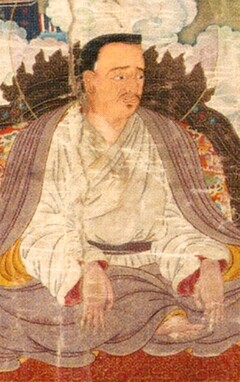Taking Death as a Friend
The Nail of Taking Death as a Friend
by Marpa Chökyi Lodrö
Homage to all sublime gurus!
When these methods[1] do not work in preventing death and a yogi meets their end, death should be taken as a friend. Worldly beings grasp death as their enemy, whereas yogis, on the basis of the guru’s oral instructions, will at the time of death, or in the bardo, take it as a friend, enabling them to attain the siddhi of Mahāmudrā.
Among the six classes of migrating beings, it is particularly true for human beings that the five signs such as optical illusions and so forth occur without fail at the time of death. There are two aspects of carrying death onto the path: 1) the natural process of dying, and 2) the way of taking it as the path.
1. The Natural Process of Dying
For the first, both when death happens gradually and when it happens all of a sudden, the following signs emerge.
At the time the earth element dissolves into the water element the outer sign is that there is a heaviness of the body. The inner sign is that smoke emerges. When fire dissolves into wind, the outer sign is that the body’s heat dissipates, beginning at its extremities. The inner sign is that the appearance of fireflies arises. When wind dissolves into consciousness the outer sign is that breathing is weak, the inner sign is that outer appearances fade, and consciousness abides clearly like a butter lamp within a vase. When consciousness dissolves into luminosity the outer sign is that the person is pronounced dead. The inner sign is that death, the Prajñāpāramita, luminous dharmakāya as it is, dawns right there at once.
2. Taking Death onto the Path
Taking death onto the path has three parts: 1) the preliminaries, 2) main practice, and 3) conclusion.
i. Preliminaries
For the common branch, depend upon a guru or Dharma friend to refresh the power of the oral instructions. Gather the accumulations by offering your possessions, otherwise they are causes of indolence and distraction. Arrange an image of your yidam deity and set out various offerings. Meditate on all phenomena as being mere dreams and illusions and engender a mind of great confidence, contemplating that: “As everything is a mere illusion it is impossible that my intentions will not be accomplished just as I wish.”
Unify this with the intention: “I shall attain luminous dharmakāya” And: “As long as I have not attained this, I shall recognize the illusory body in the bardo as such.” Again and again, project your thoughts in this way.
Visualize yourself as your yidam deity, resting your mind single-pointedly in whatever you have experienced of the completion stage practices such as Caṇḍālī and the rest.
ii. Main Practice
For the main practice, through habituating yourself to luminosity, like the merging of a river and the ocean, or the meeting of a baby calf and its mother, your uncontrived ordinary mind, mother and son, unite as one.
iii. Conclusion
After your own experience of luminosity and the characteristic of the luminosity of the bardo unify as one, finally at death, the Prajñāpāramitā, luminous dharmakāya, will be attained. If that doesn’t happen, the illusory body of the bardo remains for seven days or seven weeks. From this, during each of these periods of seven, an instance of natural luminosity will occur. If luminosity and the illusory body are not recognized, you will circle in the three realms.
Through the force of the yogi's previous momentum, the recognition of luminosity and the illusory body dawn at this time without fail. From the power of the emergence of that recognition, and relying upon the power of the body’s excellent foundation, the kāya of unified great Vajradhara will be attained.
Itthi
| Translated by Sean Ross with the kind assistance of Khenpo Tendzin Nyima and Lowell Cook and edited for Lotsawa House with the kind assistance of Ringu Tulku Rinpoche, 2023.
Bibliography
Tibetan Edition
mar pa chos kyi blo gros. "'chi ba grogs su 'khyer ba'i gzer." In dpal mnga' bdag sgra sgyur mar pa lo tsa ba chos kyi blo gros kyi gsung 'bum. [s.l.]: bod ljongs bod yig dpe rnying dpe skrun khang, 2014. Vol. 2: 252-253.
Version: 1.1-20231106
-
This text is part of a collection of instructions known as the five nails that dispel hindrances (gegs sel gzer lnga), a teaching that derives from Nāropa. In this, the present instruction is the second of the five. It is preceded by 1) the nail of taking illness as enhancement (na tsha bogs dbyung ba'i gzer) and is then followed by: 3) the nail of taking mental afflictions as the path (nyon mongs lam du slong ba'i gzer); 4) the nail of liberating thoughts in their own place (rnam rtog rang sar grol ba'i gzer); and 5) the nail of treating obstacles as riches (bar chad g.yang du blan pa'i gzer). ↩
